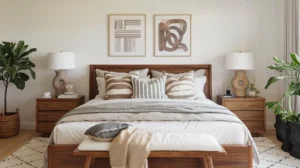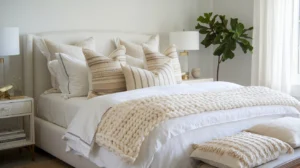This post may contain affiliate links. As an Amazon Associate, we earn a small commission at no extra cost to you.
Ever walked into a bedroom and instantly felt your shoulders drop an inch from your ears? That’s the magic of sage green and cream. This color combo isn’t just a trend—it’s practically therapy in paint form. When I redid my bedroom last year in these shades, my sister walked in and immediately said, “Well, I guess I’m copying this.” That’s the power of sage and cream.
The beauty of this palette lies in its versatility. It works in sun-drenched spaces and north-facing rooms alike. It complements both modern minimalism and traditional coziness. And unlike some color trends that scream “2025!” (hello, whatever ultra-bright color is trending on TikTok this week), sage and cream has staying power. It’s the Switzerland of color combinations—neutral, but never boring.
Whether you’re planning a total bedroom overhaul or just looking to refresh your space with a few strategic updates, I’ve gathered 20 Sage Green And Cream Bedroom Inspirations that strike that perfect balance between calming and interesting, practical and beautiful. Let’s transform your bedroom into the sanctuary you deserve.
1. Sage Green Wall Paneling with Cream Bedding
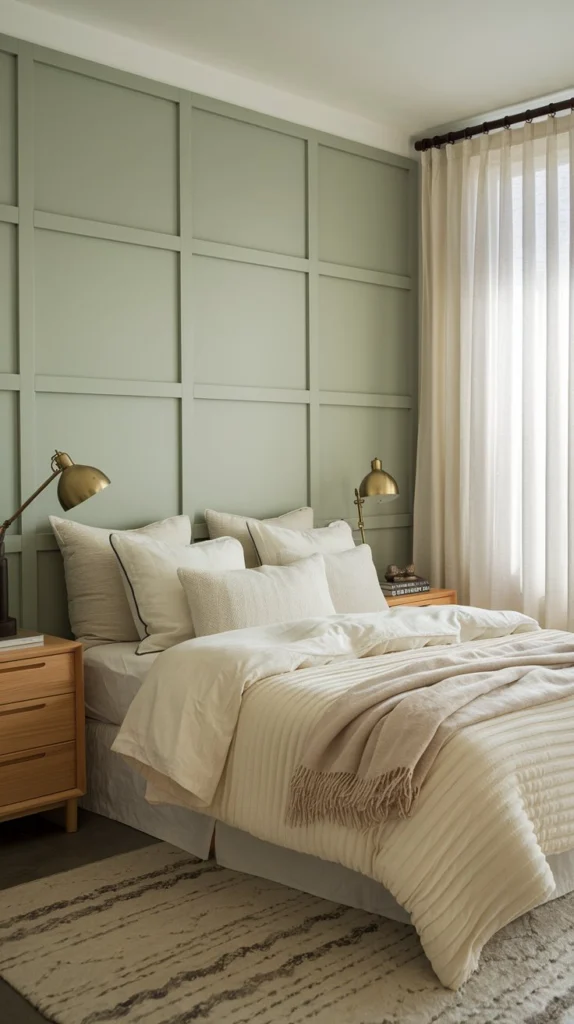
Wall paneling has made a magnificent comeback, and painting it in soft sage green creates architectural interest that flat walls simply can’t match. Whether you opt for traditional board and batten, sleek vertical panels, or classic wainscoting, this dimension-adding technique transforms ordinary walls into statement features.
The key to making this look work is contrasting your sage paneling with crisp cream bedding. The textural difference between the structured walls and soft linens creates a beautiful tension that keeps the room feeling balanced rather than one-note.
For the most luxurious effect, layer multiple cream textiles on your bed—percale sheets, a quilted coverlet, and a fluffy duvet create depth and invitation. Add a few sage accent pillows to tie the look together, creating a cohesive connection between your walls and bedding.
Recommended selections available on Amazon:
- Premium Material: Made from Pre-Washed brushed polyester, and filling with fluffy microfiber fabric, ultra soft and cozy…
- 3 Pieces Quilts Set: 1 quilt queen size (90″ x 96″) and 2 pillow shams (20″ x 26″), Oversied quilt suitable for king and…
- Striped Bedspread: Long stripe design with 10 stitches per inch, and a cross stitch every 0.9 inches to enhance durabili…
2. Two-Tone Walls: Cream Upper, Sage Lower
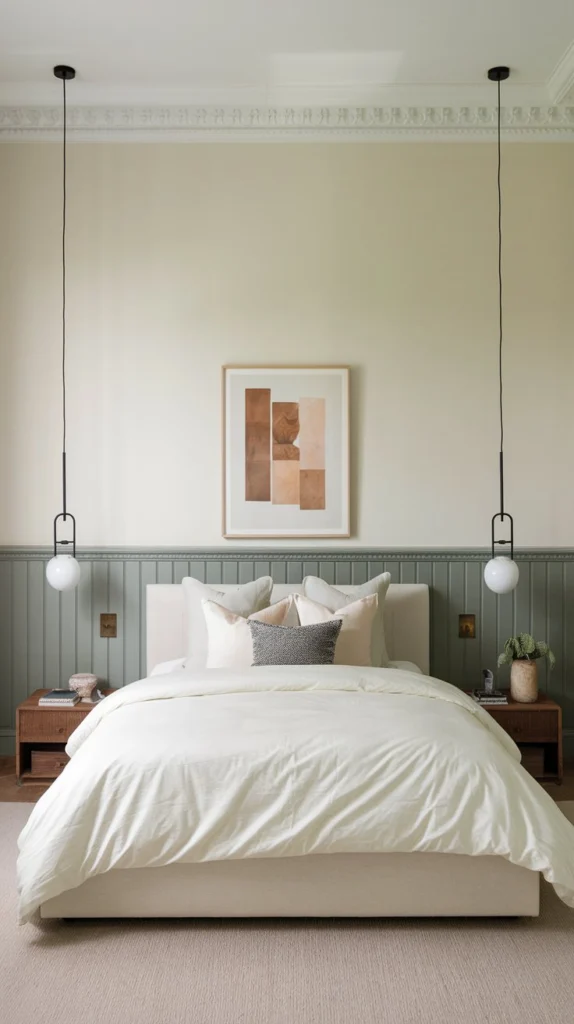
If you’re looking for a way to add architectural interest without the commitment of actual paneling, consider painting your walls in two distinct sections. A sage green lower half paired with cream above creates the illusion of wainscoting while requiring nothing more than painter’s tape and an afternoon of your time.
This technique works particularly well in rooms with high ceilings, effectively bringing the perceived ceiling height down to create a more intimate, cozy feel. The horizontal line created by the color change draws the eye around the room, making it feel wider and more spacious.
For a more traditional look, add a chair rail at the transition point between colors. If your style leans contemporary, skip the molding and create a clean, crisp line where the two colors meet. Either approach adds visual interest that plain walls simply can’t provide.
Recommended selections available on Amazon:
3. Botanical Gallery Wall
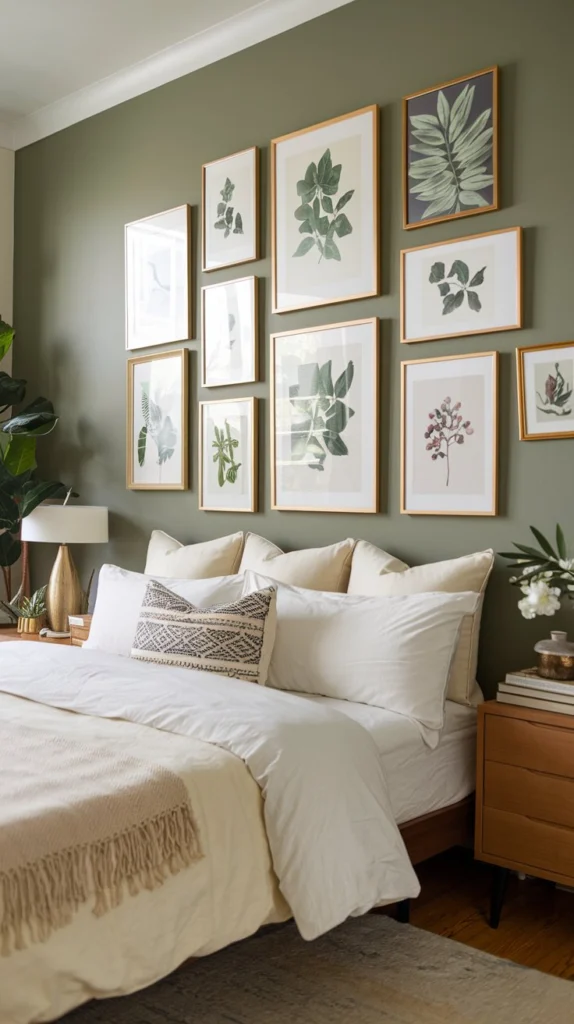
Botanical prints and sage green were practically made for each other. Create a gallery wall of framed botanical illustrations, vintage plant identification charts, or pressed herbs to enhance your sage and cream bedroom with natural elements that reinforce the organic color palette.
For maximum impact, mix frame styles while maintaining some element of cohesion—perhaps all gold frames in different widths, or a mix of materials with consistent cream mats. The variety of frames adds interest while the botanical theme creates a harmonious collection.
Don’t feel limited to store-bought art—consider framing pages from vintage botany books (readily available online), or even pressing and framing plants from your own garden. These personal touches add character that mass-produced art simply can’t replicate.
Recommended selections available on Amazon:
- Botanical Wall Art: These botanical wall art framed pictures provide sensuous qualities and beauty through 6 sage green …
- Green Plant Wall Art Prints: Eucalyptus pictures prints using HD GICLÉE printing tech ensures vibrant colors on premium …
- Botanical Prints Set of 6: 8x12inches x2, 10x14inches x2, 12x16inches x2(20x30cm x2,25x35cm x2, 30x40cm x2) Ready to han…
4. Sage Green Headboard Against Cream Walls
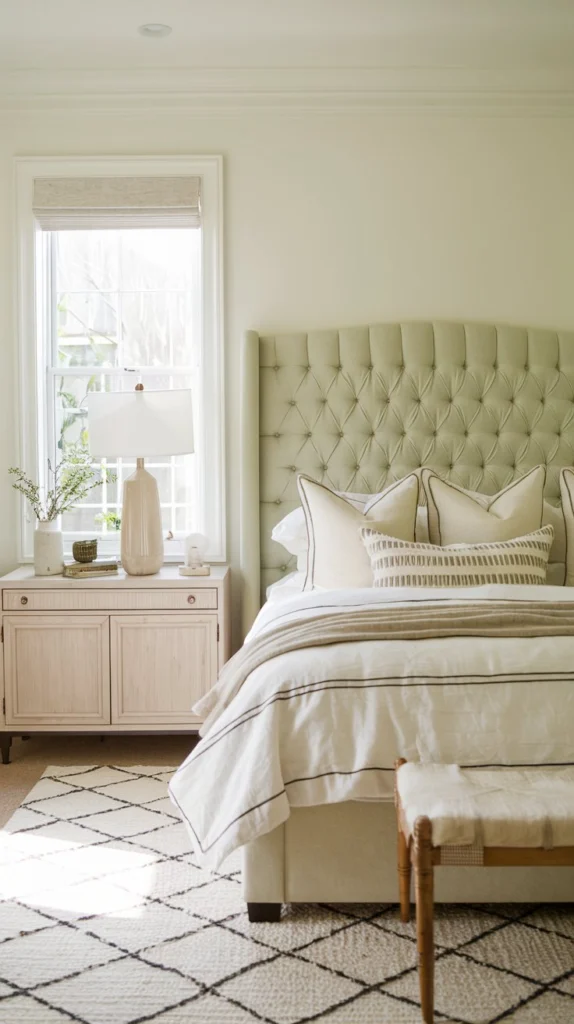
A sage green upholstered headboard creates a stunning focal point against cream walls. This approach is perfect for renters or those not ready to commit to painting—you get the magic of the sage and cream combination without changing your wall color.
Look for headboards with interesting shapes or tufting details to add another layer of visual interest. Channel tufting creates a modern, vertical line, while diamond tufting offers more traditional appeal. For something more streamlined, a simple rectangular headboard with clean lines can appear more contemporary.
The textural contrast between a soft, upholstered headboard and smooth painted walls creates depth that keeps the room from feeling flat. Enhance this effect by adding even more texture through your choice of bedding—perhaps a cream waffle-weave blanket or linen duvet cover.
Recommended selections available on Amazon:
- MODERN DESIGN: This velvet King headboard with hand-pulled tufted button and united style legs, and fine details such as…
- PREMIUM MATERIAL: Consisted from Grade-A rubber wood, high-density foam, superior-grade textured velvet fabric, this cal…
- STURDY CONSTRUCTION: The legs of this headboard king are thick and sturdy solid wood, the joints and leaning units of he…
5. Layered Cream Textiles

One of the secrets to a designer-worthy bedroom is textile layering, and a palette of cream offers endless opportunities to create depth without overwhelming color. The key is varying textures rather than introducing additional hues.
Start with cream percale sheets for a crisp foundation. Add a cotton waffle blanket, then perhaps a chunky knit throw at the foot of the bed. Finish with pillows in a variety of cream textiles—linen, velvet, and maybe something with subtle embroidery or macramé details.
Against sage green walls or with sage accents, this cream textile collection creates a serene backdrop that feels intentional rather than bland. The textural variation keeps the eye moving around the space, discovering new details with each glance.
Recommended selections available on Amazon:
- Cotton Waffle Weave Throw Blanket: The throw blanket is crafted from 100% cotton with a classic waffle weave pattern. Th…
- Pre-Washed Cotton for Extra Softness: The exteriors are made from high-quality 100% pre-washed cotton, offering a soft, …
- Layered 5-Piece Bedding Set: The 5-piece set offers a complete solution for your bedding needs. Its thoughtful design is…
6. Rattan and Natural Elements

The organic quality of sage green makes it a perfect partner for natural materials like rattan, cane, jute, and unfinished woods. These elements add warmth and texture that keeps sage and cream bedrooms from feeling too cool or one-dimensional.
Consider a rattan bed frame or headboard as your statement piece, or incorporate these natural elements through smaller accents like pendant light fixtures, mirror frames, or even a small accent chair in the corner. The warm tones of these materials create beautiful contrast against cool sage walls.
For a cohesive look, repeat your natural elements at least three times throughout the space. Perhaps a rattan headboard, a small side table with cane detailing, and a pendant light with similar materiality. This repetition creates rhythm that makes your design feel intentional rather than random.
Recommended selections available on Amazon:
7. Traditional Rug with Modern Furniture
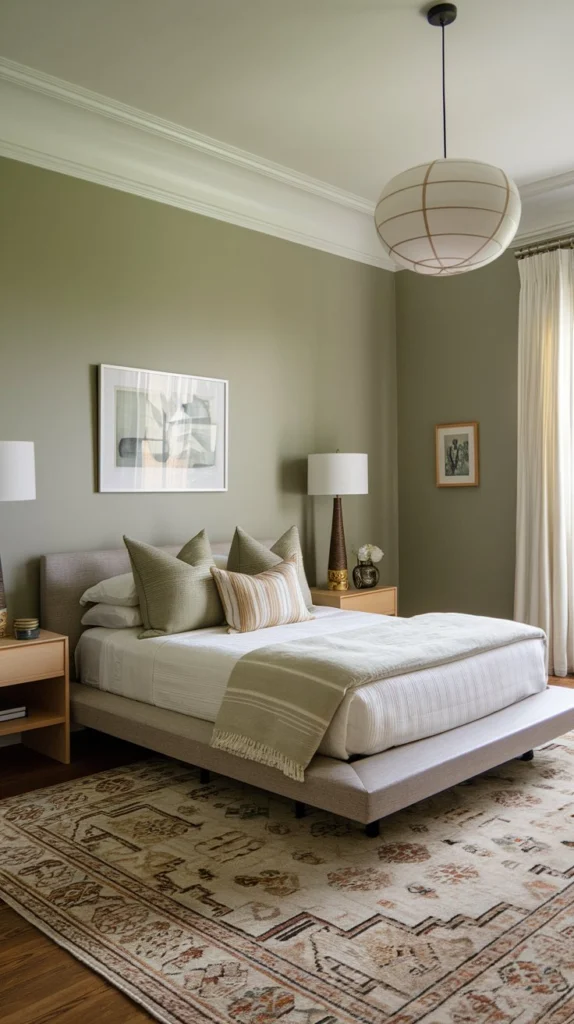
Create dynamic tension in your sage and cream bedroom by pairing a traditional patterned rug with clean-lined modern furniture. This juxtaposition of old and new creates a collected look that never feels like it came from a single store or catalog.
Look for rugs with sage green and cream as the dominant colors, perhaps with small touches of complementary hues like terracotta or navy for additional depth. Traditional Persian or Turkish patterns work beautifully in this context, their timeworn patterns softening the sometimes stark lines of contemporary furniture.
Position your rug so it extends beyond the sides and foot of your bed by at least 18 inches when possible. This generous sizing creates a defined space that feels luxurious rather than cramped, giving your furniture room to “breathe” on its foundation.
Recommended selections available on Amazon:
8. Sage Green Ceiling, Cream Walls

For the color-curious but commitment-phobic, painting your ceiling sage green while keeping walls cream offers dramatic impact with relatively low risk. Often called the “fifth wall,” the ceiling presents an opportunity to add unexpected color in a way that feels both bold and somehow subtle.
This technique works particularly well in bedrooms with architectural ceiling details like coffers or beams, but can transform even the most basic flat ceiling into a feature. The contrast between walls and ceiling creates a framing effect that can make your space feel more intimate and intentionally designed.
For maximum effect, carry your sage green down onto the top few inches of your walls, creating a subtle “tray” effect that adds architectural interest where none may have existed before. This small detail makes the color change feel intentional rather than abrupt.
Recommended selections available on Amazon:
9. Layered Window Treatments
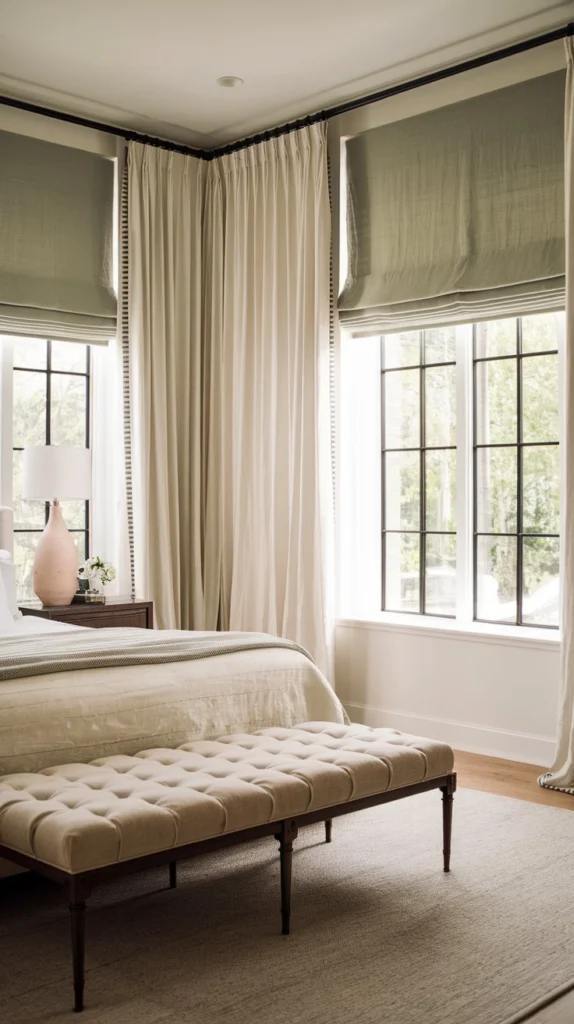
Window treatments offer another opportunity to incorporate both sage and cream into your bedroom through thoughtful layering. Consider sage green roman shades underneath cream curtain panels, or vice versa, for a sophisticated window moment that adds both color and texture.
For a more subtle approach, choose cream as your dominant window covering color with sage green appearing in trim details, tiebacks, or decorative borders. These small color accents create cohesion with the rest of your sage elements without overwhelming the window area.
When hanging curtains, position your rod close to the ceiling and extend it at least 6-12 inches beyond your window frame on each side. This designer trick makes windows appear larger and maximizes natural light—essential for making sage green read accurately rather than dull or murky.
Recommended selections available on Amazon:
10. Sage Green Accent Furniture

If painting walls feels too permanent, incorporate sage through furniture pieces instead. A sage green dresser, nightstands, or even a small accent chair can introduce this soothing color while maintaining cream as your dominant neutral.
Look for pieces with interesting silhouettes or details that deserve highlighting. Painting a carved vintage dresser in sage green emphasizes its architectural elements in a way that natural wood sometimes obscures. Similarly, a sage green velvet accent chair becomes a focal point against cream walls in a way that a brown or black chair might not.
For maximum flexibility, choose smaller accent pieces rather than your largest furniture items in sage green. This allows you to change your accent color down the road without major investment if your tastes evolve.
Recommended selections available on Amazon:
11. Modern Four-Poster Bed

A four-poster bed creates architectural presence in your bedroom while providing a perfect opportunity to incorporate either sage or cream as a statement element. Unlike ornate traditional versions, modern four-posters feature clean lines and minimal detailing that work beautifully in contemporary spaces.
For maximum impact, choose a sage green four-poster against cream walls, or a cream bed frame against sage walls. The vertical lines of the posts draw the eye upward, making your ceiling appear higher while creating a defined sleep space that feels both protected and luxurious.
Keep bedding simple with this substantial bed style—the architecture of the frame provides plenty of visual interest without requiring elaborate pillows or throws. A simple white duvet with perhaps one or two accent pillows creates a serene, uncluttered look that lets your statement bed shine.
Recommended selections available on Amazon:
12. Sage and Cream Color-Blocked Bedding
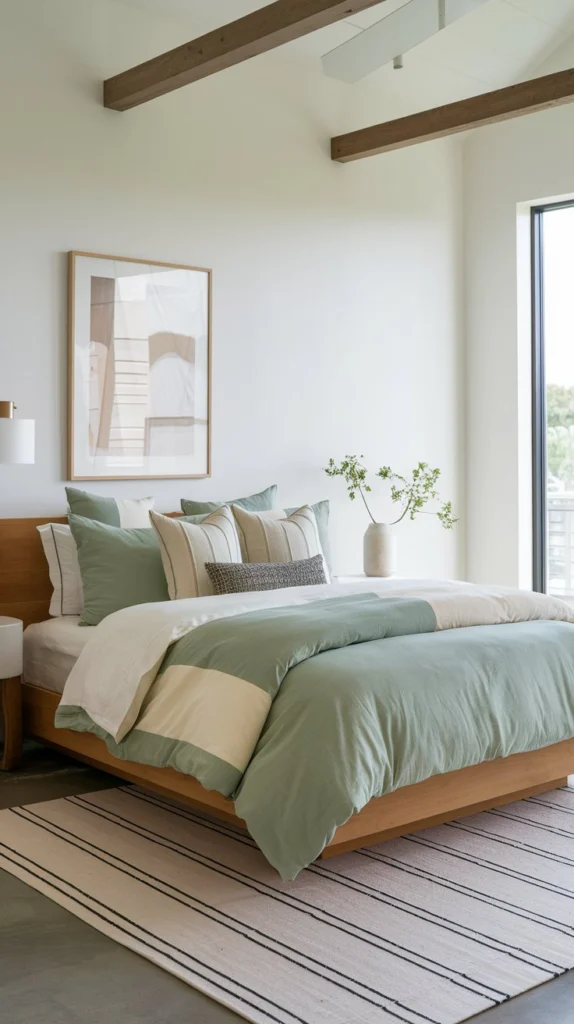
Color-blocking isn’t just for fashion—this technique creates striking bedding arrangements that feel both modern and timeless. Look for duvet covers or comforters that feature both sage and cream in clean, geometric configurations rather than busy patterns.
For a DIY approach, layer solid-colored pieces to create your own color-blocked look. Perhaps sage green sheets with a cream duvet, or a cream fitted sheet with sage top sheet and pillowcases. This mix-and-match strategy allows you to adjust the ratio of sage to cream according to your preferences.
To prevent this look from feeling too stark or contemporary, incorporate some texture—perhaps a chunky knit throw or pillows with subtle patterns that incorporate both your sage and cream tones. These softening elements keep the geometric color-blocking from appearing too rigid.
Recommended selections available on Amazon:
13. Statement Pendant Lighting
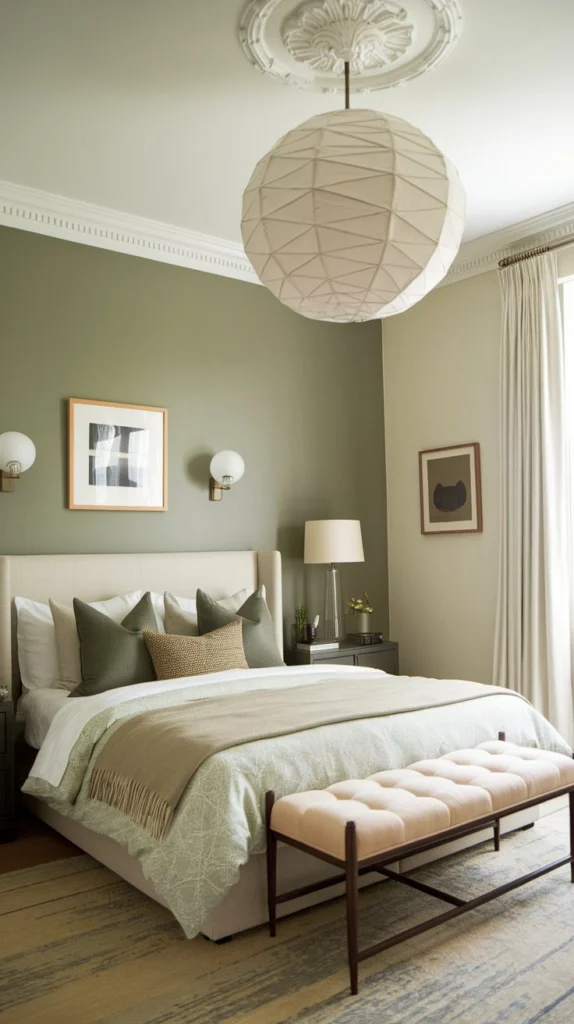
Lighting is jewelry for your room, and a statement pendant fixture can transform your sage and cream bedroom from basic to breathtaking. Look for fixtures that complement your color scheme—perhaps a brass or rattan pendant that adds warmth, or a ceramic fixture in sage or cream that reinforces your palette.
Position your statement light centrally when possible, creating a focal point that anchors your space. In bedrooms with high ceilings, choose a fixture with some volume to fill the vertical space. For standard-height rooms, more horizontal fixtures prevent the pendant from hanging too close to the bed.
Remember that bedroom lighting should be layered—your statement pendant provides ambient light, while task lighting from bedside lamps or wall sconces allows for reading. Add accent lighting through strategically placed floor lamps to eliminate shadows and create a warm, inviting glow.
Recommended selections available on Amazon:
- Versatile Style – The 19” Adesso Orb Pendant blends style and function, making it a perfect lighting solution for any ro…
- Warm Aesthetic – The collapsible rice paper shade features uneven bamboo ribs, adding texture and depth to the light fix…
- Simple Installation – Designed for easy operation, lightweight design and included socket apparatus makes installation h…
14. Tonal Sage Green Accent Wall

Not all accent walls need to introduce a completely different color. Creating a tonal accent wall using a slightly darker or lighter shade of sage green adds subtle dimension that creates interest without disrupting your serene color scheme.
This approach works particularly well behind the bed, creating a focal point that frames your headboard. The subtle color shift reads almost like a shadow, adding depth without the stark contrast of a completely different hue.
For extra impact, consider adding texture to your accent wall through grasscloth wallpaper, subtle plaster effects, or even a limewash paint technique. These applications add another layer of visual interest that flat paint alone can’t achieve.
Recommended selections available on Amazon:
15. Cream Curtains with Sage Green Trim
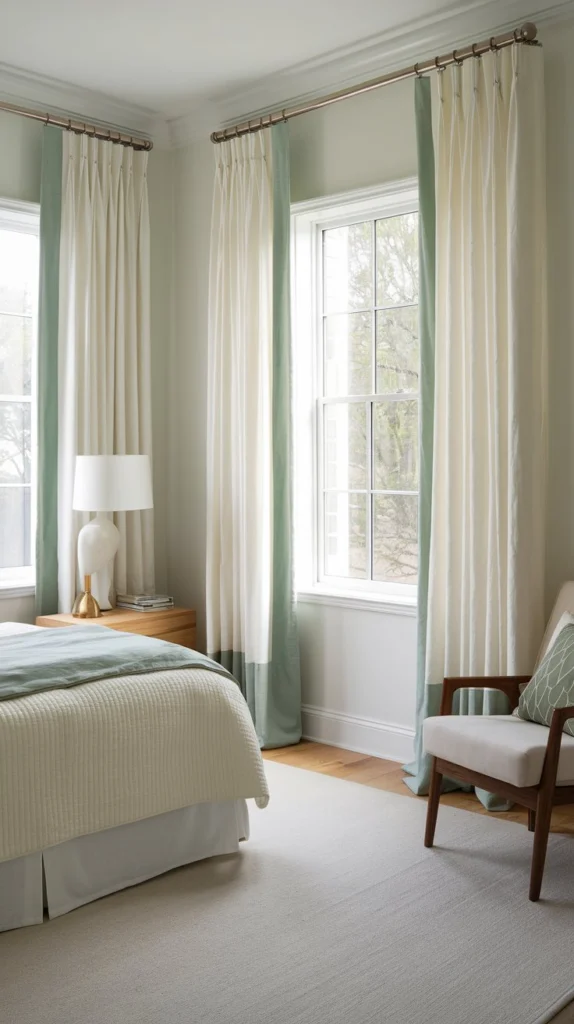
Custom-looking window treatments can transform your bedroom, and adding sage green trim or banding to cream curtains creates a designer detail that feels both classic and current. This approach introduces your accent color in a controlled way that adds interest without overwhelming your space.
Look for opportunities to repeat this detail elsewhere in the room—perhaps pillow covers with similar banding, or a throw with sage green edges. These repeated elements create cohesion that makes your design feel intentional and thoughtful.
For maximum impact, ensure your curtains are generously proportioned both in width and length. Each panel should be at least 1.5 times the width of your window, and they should either “kiss” the floor or puddle slightly depending on your style preference. These proper proportions make even simple curtains look custom and luxurious.
Recommended selections available on Amazon:
16. Sage Green Built-Ins
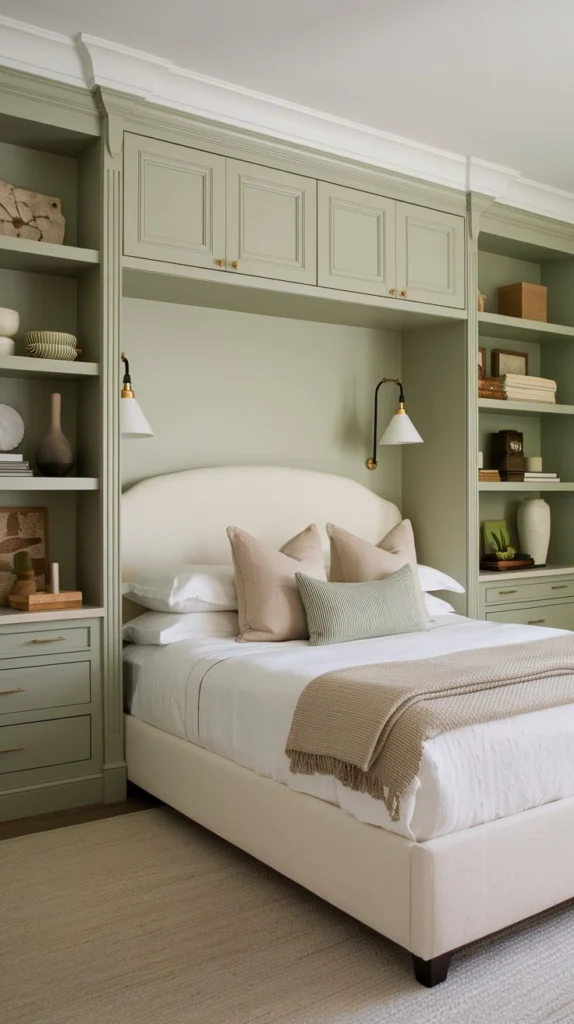
Built-in storage transforms a bedroom both functionally and aesthetically, and painting these architectural features in sage green creates a stunning focal point that also serves a practical purpose. Whether flanking your bed as nightstand alternatives or creating a reading nook under a window, built-ins add character that standard furniture often lacks.
The vertical lines of built-in cabinetry or bookshelves draw the eye upward, making your ceiling appear higher while providing valuable storage that keeps your bedroom clutter-free. Open shelving portions allow for decorative displays that personalize your space, while closed storage conceals less attractive necessities.
If true built-ins aren’t an option, create a similar effect with tall bookshelves secured to the wall and painted in your sage green shade. Add crown molding across the top to create a built-in appearance that belies these pieces’ freestanding origins.
Recommended selections available on Amazon:
- Material: Main body material: iron,Lampshade Main material: iron.
- Industrial : This wall light have made their way into our hearts and homes with their and versatility. Sleek and chic, e…
- The aesthetics of the design,Tough, and resistant to heat,no deformation of without radiation,long use life.
17. Cream Upholstered Bench
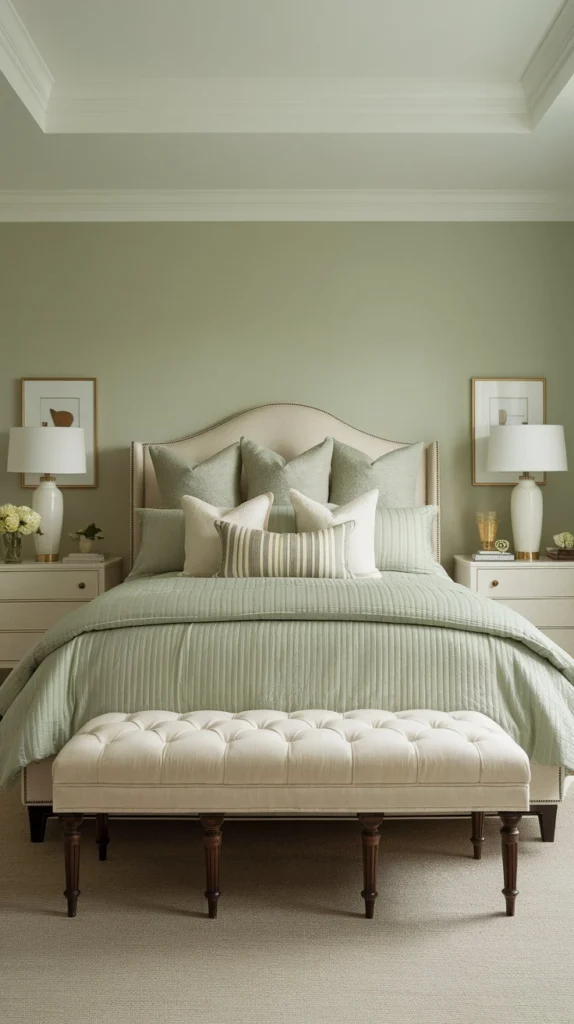
A upholstered bench at the foot of your bed adds both function and style to your sage and cream bedroom. This piece provides a convenient spot for putting on shoes, holding decorative pillows at night, or displaying a folded throw—all while creating a finished look that hotel-worthy bedrooms often feature.
Choose cream upholstery for your bench to create lightness against sage green walls or bedding. The horizontal line of a bench grounds your bed visually while providing an opportunity to introduce another texture—perhaps cream bouclé, performance linen, or even a subtle cream-on-cream pattern.
When selecting your bench, ensure proper proportions for your space. Ideally, your bench should be about 6-12 inches narrower than your bed frame and proportional in depth to your room size. This careful sizing prevents the piece from overwhelming smaller spaces while still creating substantial presence in larger rooms.
Recommended selections available on Amazon:
- High-grade material: Wood bed bench with thick breathable linen, soft cushion offers high cushioning and resilience, stu…
- Unique French Design: Retro vintage bench blends modern and French country style, tufted cushion and carved wooden legs …
- Product Dimensions: Available in 32″, 44″, 60″ lengths; Entryway bench 31.89″W x 15.75″D x 18.11″H; End of bed bench siz…
18. Modern Floral Wallpaper

Floral patterns feel fresh again when rendered in contemporary styles and colorways. Look for wallpapers featuring botanical elements in sage green against cream backgrounds, or cream florals against sage backgrounds, for a modern take on a classic pattern category.
Consider using wallpaper strategically rather than throughout your entire room. An accent wall behind your headboard creates a focal point without overwhelming the space, while papering the ceiling creates unexpected delight above. Even wallpapering the interior of built-ins or closets adds a surprise element that feels both playful and sophisticated.
For the most current look, choose patterns with some negative space rather than dense, busy designs. These airier patterns create movement and interest without the heavy feel that traditional florals sometimes bring, keeping your space feeling contemporary rather than dated.
Recommended selections available on Amazon:
- 𝐏𝐞𝐫𝐟𝐞𝐜𝐭 𝐟𝐨𝐫 𝐀𝐧𝐲 𝐑𝐨𝐨𝐦: Our removable floral wallpaper is perfect for enhancing any room. The removable floral design of t…
- 𝐄𝐥𝐞𝐠𝐚𝐧𝐭 𝐚𝐧𝐝 𝐓𝐢𝐦𝐞𝐥𝐞𝐬𝐬 𝐃𝐞𝐬𝐢𝐠𝐧: The sketch flowers design provides an elegant and timeless aesthetic that can blend well wi…
- 𝐕𝐞𝐫𝐬𝐚𝐭𝐢𝐥𝐞 𝐀𝐩𝐩𝐥𝐢𝐜𝐚𝐭𝐢𝐨𝐧: Whether you want to create an accent wall, spruce up your furniture, or add visual interest to yo…
19. Sage Green Reading Nook
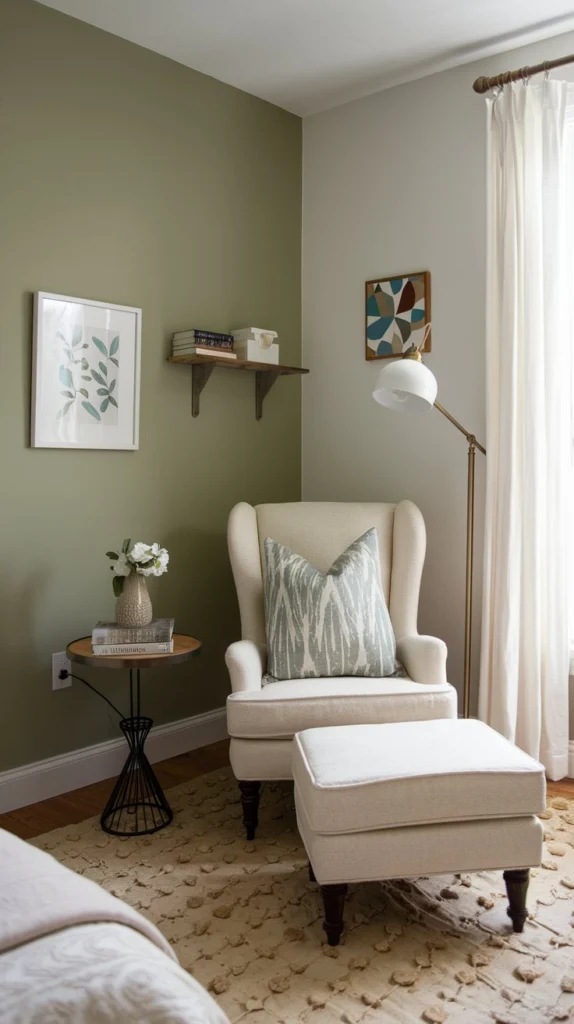
Carve out a dedicated reading corner in your bedroom by creating a sage green focal area that invites relaxation. Position a comfortable armchair in a corner, ideally near a window for natural reading light. Paint this wall sage green to differentiate the space, or use a sage green chair against cream walls for a similar effect.
Complete your reading nook with the essentials: a small side table for your tea or coffee, a reading lamp with adjustable direction, and perhaps a small ottoman or footstool for maximum comfort. A basket for blankets and current reading materials keeps everything organized yet accessible.
This designated space transforms a simple bedroom into a multi-functional retreat, providing a spot for relaxation beyond just sleeping. The color differentiation creates a room-within-a-room effect that makes even modestly sized bedrooms feel more spacious and intentionally designed.
Recommended selections available on Amazon:
20. Sage and Cream Textile Layering
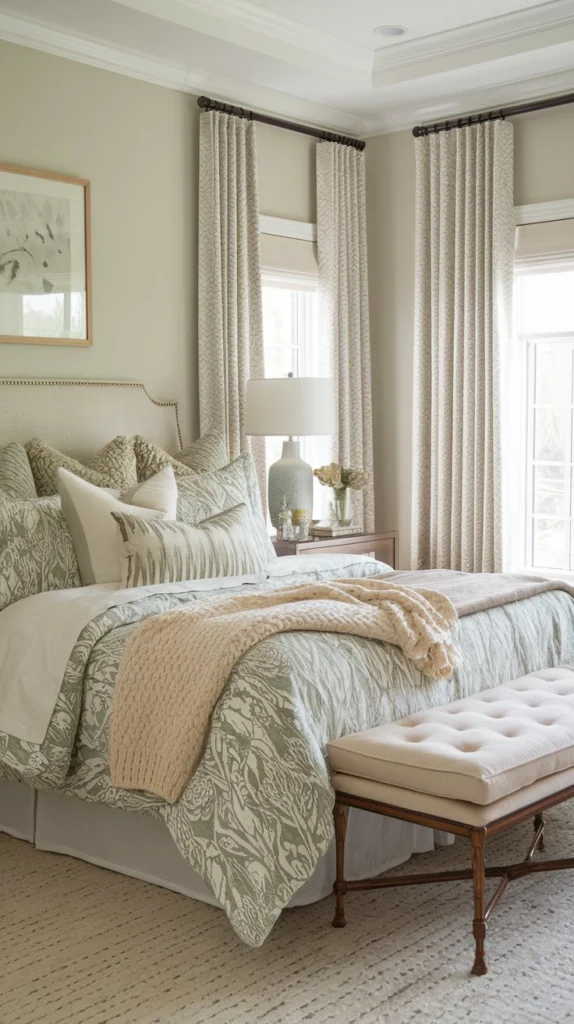
For those who prefer to keep walls neutral, textile layering offers endless opportunities to incorporate sage green and cream throughout your bedroom. This approach allows for seasonal adjustments and easy updates without the commitment of paint or wallpaper.
Begin with a foundational cream duvet or comforter, then add sage green sheets visible when the bed is turned down. Layer on throw pillows in both colors, perhaps incorporating subtle patterns that combine the two. A chunky knit sage throw at the foot of the bed adds another color moment while providing practical warmth.
Extend this textile strategy beyond your bed with cream curtains, perhaps a sage green ottoman, or even artwork that incorporates both hues. This distributed approach creates color consistency throughout your space without concentrating too much sage in any one area.
Recommended selections available on Amazon:
Bringing It All Together
The beauty of sage green and cream lies in its versatility. Whether you’ve gone all-in with sage walls and built-ins or simply added touches of this soothing hue through textiles and accessories, you’ve created a space that feels both timeless and thoroughly current.
Remember that the most successful bedrooms evolve over time. Don’t feel pressured to implement every idea at once—start with the elements that speak most strongly to you, then add and adjust as you live with your space. The personal touches you add along the way will transform these ideas from inspiration to a bedroom that truly feels like yours.
I’d love to see how you incorporate sage and cream into your own bedroom!
Check out these 20 Cozy Neutral Bedrooms Ideas to kickstart your next makeover.
Sweet dreams in your new sage and cream sanctuary!







































